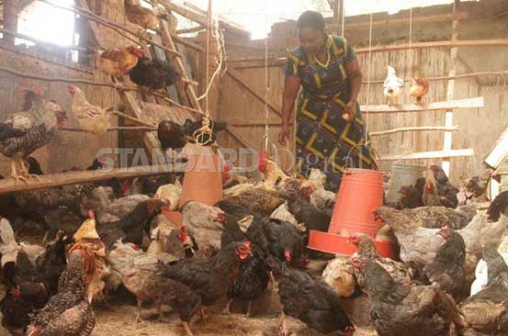
The El Niño rains come with many challenges for farmers. Today, we look at two poultry diseases that follow heavy rains.
The flood waters provide favourable conditions for multiplication and growth of disease causing micro-organisms in the environment, feed and even body of animals.
Flood waters can uncover and spread these disease causing micro-organisms from their confines deep in the earth’s belly. Moist conditions spoil feeds and make them unsuitable for consumption by birds in addition to causing stress that further predispose poultry to diseases.
In as much as this article is limited to two diseases it is important to note that cold weather during heavy rains is a cause of stress to poultry.
Stress normally results in a weakened immune system, hence predisposing birds to many other diseases. Generally speaking, expect a higher disease incidence and worm infestation during and after heavy rains.
Avian Botulism
You have perhaps heard of Botox cosmetic injections given to people especially ladies to eat away facial wrinkles that come with age. The science behind Botox injections is a toxin that affects nerves by “killing” them; hence preventing wrinkling. This toxin causes a fatal disease in human beings, wild and domestic animals.
Botulism is caused by a highly poisonous bacteria whose spores can survive in an environment with low oxygen for example deep in the soil for long periods.
The bacteria are mainly found in soils, rotting vegetation or animal carcasses; other ground insects like white ants and termites (mchwa and kumbe kumbe) can come in contact with botulism spores and become contaminated and can further infect birds and human beings feeding on these insects.
Botulism is a common poultry disease following floods. Wild and free range birds have high chances of consuming decomposing carcasses of animals killed by flood waters.
This disease in birds is mainly caused through consumption of contaminated insects, vegetables or decomposing animal carcasses or drinking water contaminated with botulism toxin. Botulism is thus very common in free range chicken, ducks, geese and guinea fowl following floods. Fly larvae (maggots) that feed on decomposing carcasses are resistant to the toxin but can pass it on to birds that feed on such maggots effectively spreading the disease.
The main clinical signs of botulism in poultry are general paralysis that makes swallowing of food and walking difficult followed by general body weakness. The affected birds will lay on the ground in groups unable to walk. The disease can kill a bird very quickly before a farmer notices.
Botulism is prevented by confining poultry in a clean house until when wet weather conditions are replaced by warm dry weather conditions. Collection and disposal of dead birds and disinfection of the house will prevent further spread. Proper disposal of animal carcasses will greatly reduce chances of contact with the causative bacteria or infected maggots.
Treatment can be done using antibiotics or anti-toxins depending on the type and number of affected birds. This should be supported by tube feeding where birds have already lost the swallowing ability.
Stay informed. Subscribe to our newsletter
Brooder pneumonia
Excess rain is already a cause of stress in birds; such birds have a reduced immunity and hence can easily get pneumonia.
Brooder pneumonia is caused by fungal spores that develop in wet conditions but are spread through inhalation in dry dusty conditions. Heavy rains in improperly constructed poultry houses can easily create conditions favourable for the fungal spore growth. Brooder pneumonia is common in housed birds.
Birds suffering from pneumonia will have difficult or fast breathing, gasping for air or coughing and a reduced appetite but increased thirst.
To prevent birds from pneumonia following floods maintain dry warm conditions within the poultry house and don’t feed birds on wet and moldy feeds. Feeds initially moldy but dried may look good for poultry consumption but can easily serve as source for the bacterial spores.
Raising poultry house from the ground can cushion birds against floods and help in maintaining warm conditions. Though normally ineffective veterinary intervention can be attempted but the disease will in most cases be cured if further exposure to the fungal spores is stopped.
How to beat the cold
Prepare well for the rainy season if you are a poultry farmer. As the Meteorological Department warns of above average rains; that is the time to check your poultry house if it is in good condition to stand the rains. If yours is a free range system you may need to consider housing your birds if you wish to keep avian botulism at bay.
Ensure you have had your birds vaccinated as per the veterinary guide. Store your feeds in a secure place out of reach by the flood waters and keep checking for any wetness or growth of molds. During the rains check for any cold or wetness and any signs of stress in the birds and quickly put in place corrective measures. When you notice any sick bird immediately isolate it from the rest and report the case to your veterinarian.
(The writer is a veterinary surgeon working as a Communication Officer for the Kenya Tsetse and Trypanosomiasis Eradication Council –KENTTEC)
 The Standard Group Plc is a
multi-media organization with investments in media platforms spanning newspaper
print operations, television, radio broadcasting, digital and online services. The
Standard Group is recognized as a leading multi-media house in Kenya with a key
influence in matters of national and international interest.
The Standard Group Plc is a
multi-media organization with investments in media platforms spanning newspaper
print operations, television, radio broadcasting, digital and online services. The
Standard Group is recognized as a leading multi-media house in Kenya with a key
influence in matters of national and international interest.
 The Standard Group Plc is a
multi-media organization with investments in media platforms spanning newspaper
print operations, television, radio broadcasting, digital and online services. The
Standard Group is recognized as a leading multi-media house in Kenya with a key
influence in matters of national and international interest.
The Standard Group Plc is a
multi-media organization with investments in media platforms spanning newspaper
print operations, television, radio broadcasting, digital and online services. The
Standard Group is recognized as a leading multi-media house in Kenya with a key
influence in matters of national and international interest.










